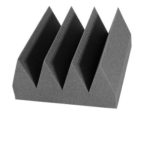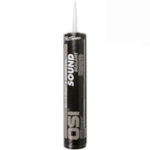
A walk-in closet can be a beautiful thing. In addition to being a great way to organize your clothes, it can be a terrific little refuge from the outside world — but not if sounds from outside the closet keep blasting in. What you really want is a space you can go into, close the door and focus for a few minutes of the day.
Fortunately, there are several affordable and easy closet soundproofing options available to you. Here are some ideas on how to soundproof a closet that shouldn’t break the bank:
1. Use Acoustic Panels for Soundproofing a Closet
Try attaching acoustic panels. Acoustic panels are a great option because they are easy to install and do a great job of absorbing unwanted sound. You can get a dramatic improvement of the sound quality inside your closet without having to overhaul the whole room. Also, thanks to the variety and color of fabric-wrapped panels from Soundproof Cow, this is a way to decorate and beautify your closet, as well.
The soft texture of acoustic panels is key to their ability to improve the sound quality of a room. When hanging acoustic panels in your closet, you’ll experience fewer unwanted echoes and lingering frequencies. You’ll notice interior noise sounds better in your closet thanks to the addition of acoustic panels.
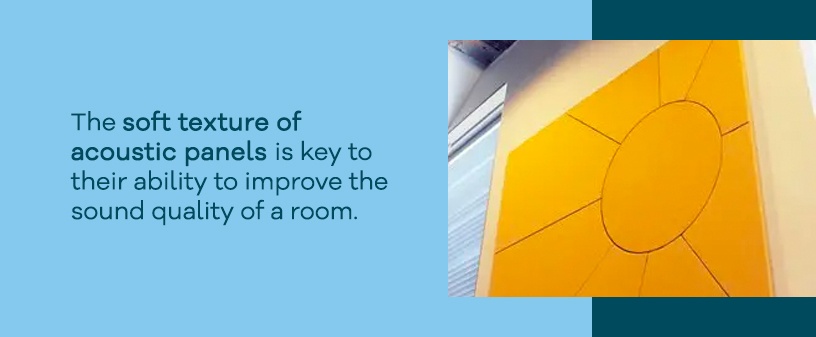
2. Install Studio Foam Bass Traps
Studio foam bass traps are foam sound absorbers specially shaped to catch unwanted low-frequency sounds. They are commonly used in recording studios to clean up sound. When you produce low-frequency sounds from a kick drum or a subwoofer, those frequencies can collect in the corners of your closet and bounce around the room. This leads to a muddy, unclear sound that can be unpleasant to listen to and disturbing to your neighbors. Foam bass traps stop these unwanted results from happening.
The advantage of these is that you can drop them anywhere, so no complicated rearranging is necessary. Soundproof Cow even has specially designed corner studio foam and traps in a variety of colors to suit your closet.
3. Seal the Cracks
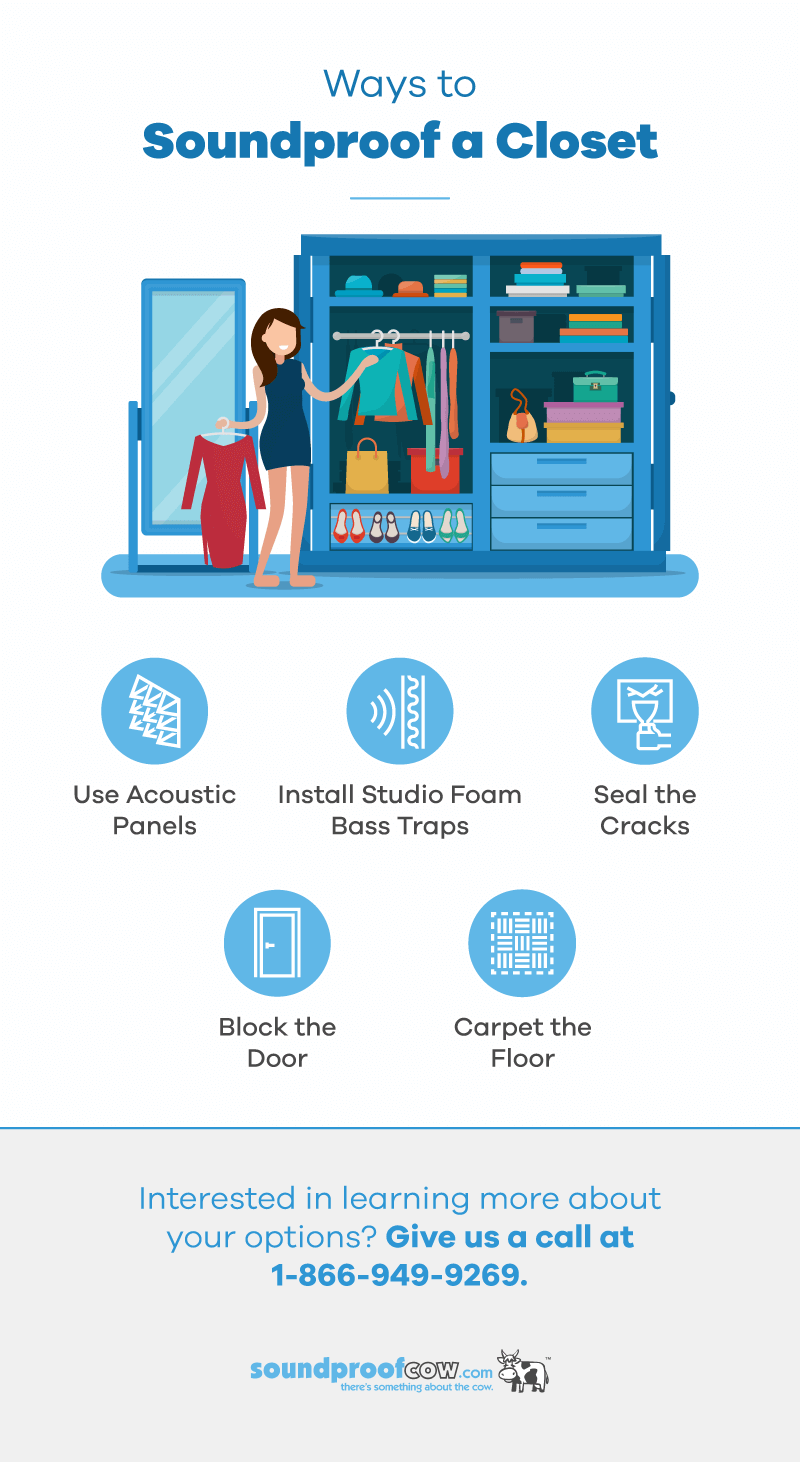
Sound always finds its way through cracks and openings. For this reason, you’ll want to inspect your closet for any cracks in the wall, ceiling and flooring. If there are any cracks or gaps in your closet wall or door, cover them with weatherstripping or acoustic sealant. Make sure it is an acoustic sealant, as a standard sealant can shrink and crack, allowing sound through. Once you’ve sealed these cracks, your closet will be much better at keeping unwanted sounds from traveling in or out.
4. Block the Door
A lot of unwanted sounds can come right in through the closet door, even if you have made an effort to seal off the gaps and cracks. Many closet doors are made with light or hollow materials. This makes them one of the main culprits when it comes to sound traveling in and out of your closet.
To deal with this, you can hang a moving blanket in front of the door, either on the outside or the inside, to catch unwanted sounds from coming in. Moving blankets are thick enough to absorb plenty of sound from both directions. Having a soundproof closet door lets you make noise or enjoy peace and quiet in your closet with confidence.
5. Carpet the Floor for a Soundproof Closet
Harsh noises can bounce off hard floors and travel around the room, creating interfering and unwanted frequency. A carpeted floor or a large rug can catch those sounds before they cause problems. Opt for a heavy, thick carpet, or you can choose one that has interlocking stitches for extra sound absorption. A heavy carpet on the ground will do a lot to keep you from disturbing your downstairs neighbors — or being disturbed by them.
Tips for Turning Your Walk-In Closet Into a Recording Studio
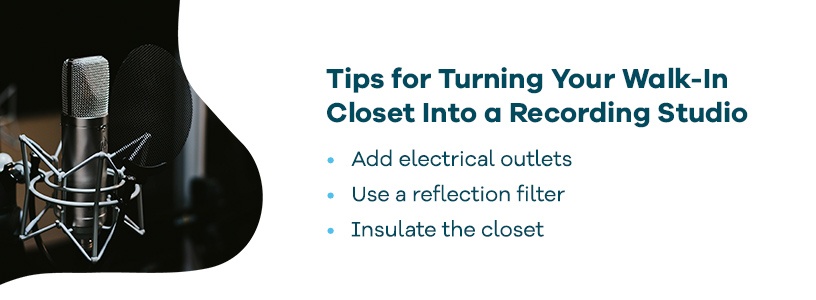
One of the most popular uses for a walk-in closet is to turn it into a small recording studio. With proper soundproofing, the space provided by a walk-in closet is small enough to help you achieve excellent recording quality while large enough for you to stand, sing and play your instruments with ease. After following the above recommendations, here are some tips to keep in mind if you want to create a recording studio closet:
- Add electrical outlets: Recording studios need access to electricity to run your various pieces of recording equipment. Some large closets may lack outlets, so you’ll have to add some yourself or with the help of an electrician. Make sure you soundproof your outlets with pieces of acoustic fiberglass to stop sound from transferring through these newly crated openings.
- Use a reflection filter: When recording vocals, you should surround the back of your microphone with a reflection filter. These devices implement a curved shape to capture sound around your microphone and stop it from echoing around the room. It could also stop other noises in your studio from bleeding into your vocal recording.
- Insulate the closet: If you really want to take your closet recording studio to the next level, you can reinsulate the entire thing with acoustic fiberglass. This will involve opening up your closet walls to fill the area between the studs with insulation. It will be a bit more work, but the results are worth it. For a less invasive soundproofing project, add another layer of drywall to your existing wall, bonding them together with Green Glue Noiseproofing Compound.
Soundproof Your Closet With Soundproof Cow
Of course, there’s no reason you can’t fully soundproof your closet with wall-to-wall soundproofing installation. However, if you are not ready for a major renovation yet, the above suggestions may do the trick. To find out which of the ideas will work best for your closet, call Soundproof Cow. We can offer suggestions or provide a free acoustic analysis for your closet.
If you’re ready to enjoy the benefits of a sound-resistant walk-in closet, we’d love to help. Order the right soundproofing products today or contact us for your free acoustic analysis.







